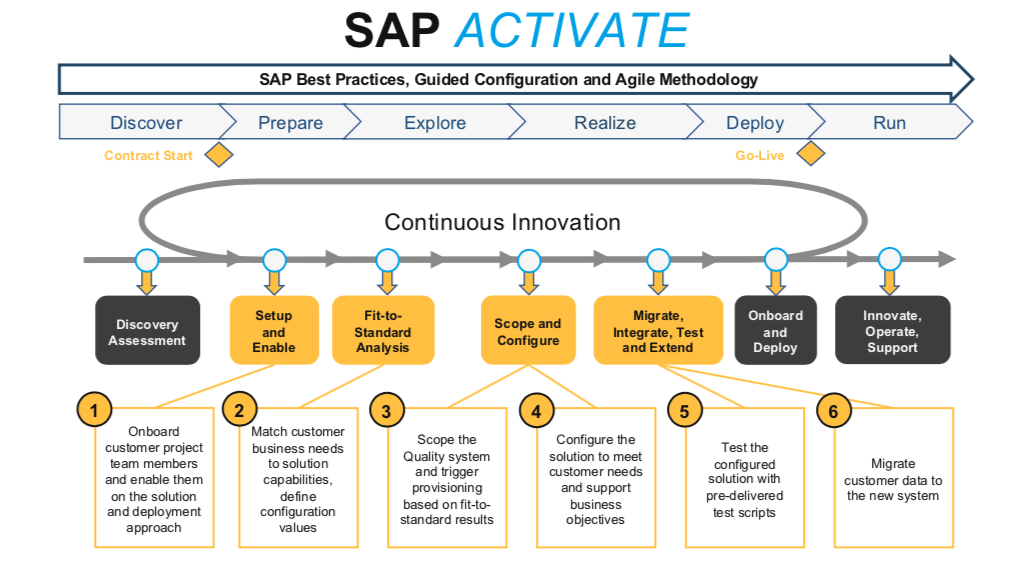What Is SAP Activate Methodology?

Effective implementation is the foundation of every successful software deployment project. The more organised and thorough the process, the more empowered your business will be to leverage the full potential of your software.
For deploying SAP cloud applications such as SAP SuccessFactors and S/4HANA, SAP’s cloud-based ERP solution, your business, along with your implementation partner, can use SAP Activate, SAP’s powerful methodology for enabling agile SAP project implementation. It consists of three pillars: SAP Best Practices, guided configurations, and a six-phase implementation project lifecycle, and it’s an essential tool for ensuring a solution is properly configured for your needs and meets all of your business's requirements.
Before we unpack the methodology, let’s explore why using SAP Activate is so important.
Why Use SAP Activate?
Whether your business is looking to deploy SAP cloud applications for the first time or you’re ready to migrate or upgrade to SAP cloud products, you’ll need to follow a series of steps and best practices to safely transition from project scope to going live.
With SAP Activate, you can minimise the risk of human error and experience seamless integrations with other SAP cloud software and third-party applications. Your SAP implementation partner will work with your teams through each stage, ensuring all deliverables are met and helping you take an agile approach, so your software is configured to best serve business goals.
How Is SAP Activate Different Than ASAP Methodology?
SAP Activate is the most advanced implementation and project management methodology for SAP customers. It builds on the foundations of ASAP methodology, which is commonly used to implement SAP on-premise solutions.
Because SAP is constantly evolving its products, it needed a more dynamic system to help customers take advantage of the huge and ever-evolving range of tech stacks, configurations, and destinations that are possible. With SAP Activate, customers can more easily modernise their software stack to suit business needs. It also includes explicit support for both waterfall and agile methods.
SAP Best Practices and Guided Configuration Content
SAP has created a library of accessible content and other tools to help SAP customers, and their SAP S/4HANA and SuccessFactors implementation partners to support in the fulfilment of agreed project activities underpinned by the SAP Activate methodology.
- SAP Best Practices combines over 45 years of SAP’s industry-specific knowledge and experience with the most up-to-date best practices for integration, migration, and extensibility. It includes roles and responsibilities, standard test scripts, and business process flows. This is a cloud-based reference solution that you can use to access real-time updates to best practices.
- The guided configuration content includes administration tools, setup wizards, historical content, and how-to guides on product and implementation topics. The purpose of this pillar of the SAP Activate framework is to simplify the process of configuring your SAP system with a self-service configuration user experience.
What SAP Activate’s Six-Phase Implementation and Project Management Methodology Looks Like
The SAP S/4HANA and SAP SuccessFactors implementation methodology consist of a six-phase project lifecycle. The six phases are:
- Discover – Define goals based on where your company is within its SAP journey. This phase involves technical research, which is conducted by your SAP SuccessFactors consulting partner.
- Prepare – Set up a project plan, which will draw upon details from the Discover phase, including your migration strategy and IT management approach.
- Explore – Refine business requirements, confirm businesses processes, review details and prepare for implementation and system conversion.
- Realise – Development environment build and test the configuration and migration process while finalising end-user training materials and documentation,
- Deploy – Setup the production system and IT infrastructure, migrate organisation data and complete all end-user training.
- Run – Make adjustments to system settings, configure new tools, and take other steps to fine-tune the software now that it’s deployed.
Within those phases, your teams will work with the main building blocks of the methodology: collections of related tasks referred to as streams. As you move through a specific stream, you’ll achieve one or more pre-determined deliverables.
The streams are then grouped into milestones known as Quality Gates or Q-Gates. Each Q-Gate marks the completion of one of the first five phases. The purpose of the Q-Gates is to give stakeholders the opportunity to evaluate the project’s progress and confirm that all deliverables have been met. Once this is done, the project moves on to the next phases.

(image: Discovery Consulting)
Using an agile approach, your teams will follow a process of continuous innovation as you move through each stream and Q-Gate. This is why the SAP Activate methodology is so effective – your teams are constantly looking for ways to optimise the project so the software is configured in a way that will best serve your organisation.
Experience the Benefits of a Tailored Approach to SAP Activate
At Discovery Consulting, we use an end-to-end delivery approach for SAP cloud implementation. In addition to following the six phases outlined in the implementation and project management methodology, we enact our own steps in tandem with the six phases:
- Assessment
- Project Verification
- Solution Acceptance
- Readiness Acceptance
- Go-Live
- Solution Operability
We also use a specific suite of activities for legacy management, as well as for change management and benefits realisation. With additional project verification and solution acceptance steps, all tailored to your business’s objectives, we’re able to simplify implementation projects, helping you achieve more with your software and streamlining deployment.
Contact our team today to learn more about how our implementation roadmap can enable your organisation to get more out of SAP cloud products.

